A beautiful sunny day in the early days of spring. How do I know that it's spring?
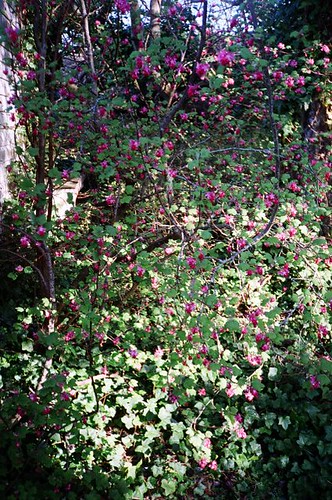
This is a hint; First i had to cut my father-in-law's grass on Feb. 26th. Then I shot this tree in bloom on February 27th on Discovery. There was also a dandelion in full bloom. Spring is clearly here, even if the rain doesn't want to agree.

This twisted old bugger has survived another winter of gales on Discovery. Interesting how life on small islands tends to show the greatest range of adaptation because of the extreme conditions. (Yes Mr. Darwin, you said it first).
The trip over was uneventful. The only real difference is that I headed over from closer to Cadboro Point and ended up a couple of hundred metres off the north end of the islands. The inlet marked by the star is really quite extensive, and is at least a part-time home to some of the otters that feed in these waters.
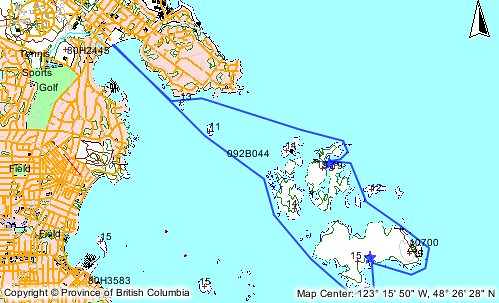
I spent a large part of the day on Discovery, waiting for the tide to turn. I really didn't want to be paddling flat out and going backwards. The currents in Baynes and Plumper were at full blast for most of the afternoon, but dropped off towards evening, finally hitting slack at around 6:00pm.
The extended stay let me wander about the island, exploring the park side to my heart's content. (Discovery is park on the east side and First Nations territory on the west).
The trail through the park goes from Sea Bird Point on the northern side to Commodore Point to the south (and no, no Lionel Ritchie sightings). Sea Bird Point is not accessible by foot, as the lighthouse and boarded-up lighthousekeeper's house are fenced off. But the heights are accessible, making for great views.
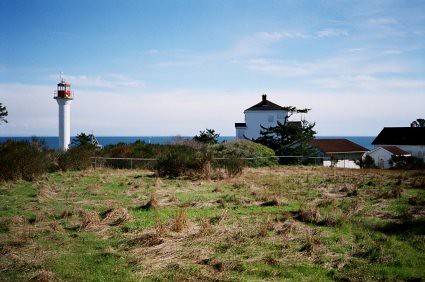
With the number of rocks and other features off the point, it's clear why a light is needed. But it must have made for long winters to be the keeper of the light.

This is the "Orange Tiara" off the point, shot from the heights. You can see the rocks off the point between the camera and the ship. There was a steady 4 knots or so current running about these rocks when I shot the picture. Definitely not something to be fighting against if you're a kayaker.

Ships pass the island constantly. You almost never ear anything from them, even when they pass within two or three kilometres of you. Yet without a ship in sight (and I used my binoculars to check) there was suddenly this low booming/industrial sound coming over the water. I never did figure out what it was.
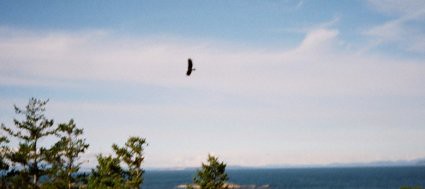
There was, of course, the obligatory eagle flyby. Actually there were thhree or four eagles, but I only got a shot at one.
Rudlin Bay is quite big for the size of the island, and the late winter/early spring water is clear and inviting. I kept wanting to just dive in--but I did show at least a modicum of good sense and declined hypothermia.
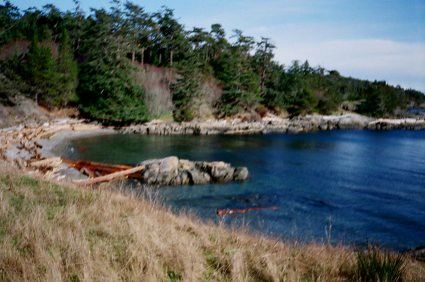
On the north end of the island is an abandoned boathouse and dock.
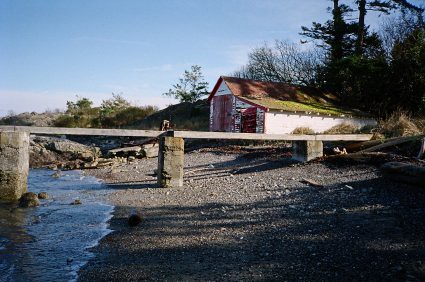
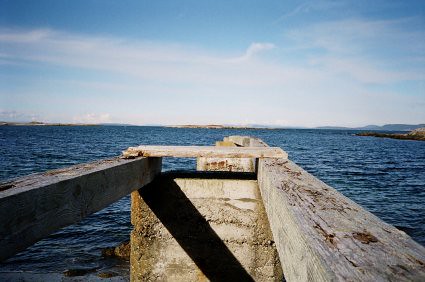
Checking my chart later, I realized that this was probably on the First Nations side of the island. My apologies to all concerned.
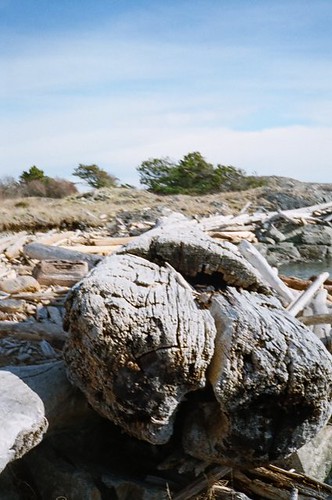
There is so much driftwood piled on the beaches. This log is on Commodore Point. It makes for a great highway when beachcombing/exploring.
All in all, just another day in paradise.

This is a hint; First i had to cut my father-in-law's grass on Feb. 26th. Then I shot this tree in bloom on February 27th on Discovery. There was also a dandelion in full bloom. Spring is clearly here, even if the rain doesn't want to agree.

This twisted old bugger has survived another winter of gales on Discovery. Interesting how life on small islands tends to show the greatest range of adaptation because of the extreme conditions. (Yes Mr. Darwin, you said it first).
The trip over was uneventful. The only real difference is that I headed over from closer to Cadboro Point and ended up a couple of hundred metres off the north end of the islands. The inlet marked by the star is really quite extensive, and is at least a part-time home to some of the otters that feed in these waters.

I spent a large part of the day on Discovery, waiting for the tide to turn. I really didn't want to be paddling flat out and going backwards. The currents in Baynes and Plumper were at full blast for most of the afternoon, but dropped off towards evening, finally hitting slack at around 6:00pm.
The extended stay let me wander about the island, exploring the park side to my heart's content. (Discovery is park on the east side and First Nations territory on the west).
The trail through the park goes from Sea Bird Point on the northern side to Commodore Point to the south (and no, no Lionel Ritchie sightings). Sea Bird Point is not accessible by foot, as the lighthouse and boarded-up lighthousekeeper's house are fenced off. But the heights are accessible, making for great views.

With the number of rocks and other features off the point, it's clear why a light is needed. But it must have made for long winters to be the keeper of the light.

This is the "Orange Tiara" off the point, shot from the heights. You can see the rocks off the point between the camera and the ship. There was a steady 4 knots or so current running about these rocks when I shot the picture. Definitely not something to be fighting against if you're a kayaker.

Ships pass the island constantly. You almost never ear anything from them, even when they pass within two or three kilometres of you. Yet without a ship in sight (and I used my binoculars to check) there was suddenly this low booming/industrial sound coming over the water. I never did figure out what it was.

There was, of course, the obligatory eagle flyby. Actually there were thhree or four eagles, but I only got a shot at one.
Rudlin Bay is quite big for the size of the island, and the late winter/early spring water is clear and inviting. I kept wanting to just dive in--but I did show at least a modicum of good sense and declined hypothermia.

On the north end of the island is an abandoned boathouse and dock.


Checking my chart later, I realized that this was probably on the First Nations side of the island. My apologies to all concerned.

There is so much driftwood piled on the beaches. This log is on Commodore Point. It makes for a great highway when beachcombing/exploring.
All in all, just another day in paradise.
powered by performancing firefox

just wondering what and were is the building on Discovery in the top picture by the flowers?
ReplyDeleteWow, that was like 18 months ago! Probably taken near the lightkeeper's house at the north-east end of the Island. The place was obviously a home to somebody or somebodies back in the day--there's a house, worksheds, old gardens, tonnes of flowers. It looks to have been a great place. It would make a terrific bed and breakfast with a helluva view!
ReplyDelete